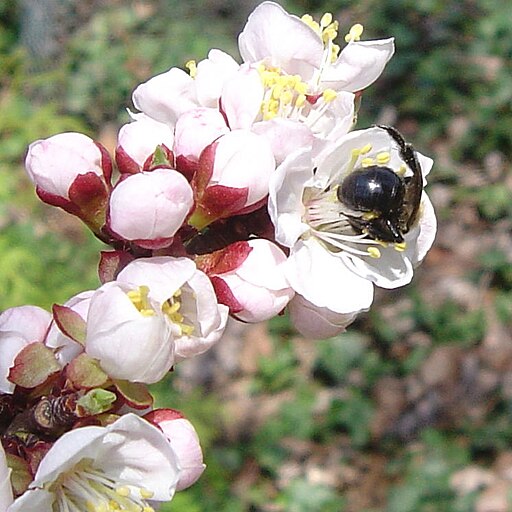Classification System: APG IV
Superregnum: Eukaryota
Regnum: Plantae
Cladus: Angiosperms
Cladus: Eudicots
Cladus: Core eudicots
Cladus: Rosids
Cladus: Eurosids I
Ordo: Rosales
Familia: Rosaceae
Subfamilia: Amygdaloideae
Tribus: Amygdaleae
Genus: Prunus
Subgenus: P. subg. Prunus
Sectio: P. sect. Armeniaca
Species: Prunus mandshurica
Varietas: P. m. var. glabra – P. m. var. mandshurica
Name
Prunus mandshurica (Maxim.) Koehne (1893)
Synonyms
Basionym
Prunus armeniaca var. mandshurica Maxim., Bull. Acad. Imp. Sci. Saint-Petersbourg 29(1): 87. 1883.
Homotypic
Armeniaca mandshurica (Maxim.) Skvortzov, Trudy Prikl. Bot. 22: 223. 1929.
References
Koehne, B.A.E. 1893. Deutsche Dendrologie 317.
USDA, ARS, National Genetic Resources Program. Germplasm Resources Information Network - (GRIN) [Online Database]. [1]
Vernacular names
беларуская: Абрыкос маньчжурскі
Prunus mandshurica, also called Manchurian apricot and scout apricot, is a tree in the genus Prunus.
It was first described by Karl Maximovich in 1883 as a variety of the Siberian apricot (Tibetan apricot) Prunus armeniaca.[2] It is resistant to cold and is native to northeast China, Korea, and Manchuria. It is highly susceptible to plum pox potyvirus.[3]
Description
Prunus mandshurica is a deciduous, broad-leaved tree, which grows to a height of about 10 m (33 ft). The inner bark is red and the outer bark is black. The leaves are oval, with an elongated tip (acuminate or caudate), some hairs, and serrated edges. The tree grows best in loam soils. Its petioles are 3 cm (1.2 in). The sepals and petals are oval, while the length of the stamens is similar to that of the stigma, which is cup-shaped. Flowers appear in spring and are white or pale pink.[4] Fruits appear in late summer and are yellow with some red. In the autumn, the leaves turn golden orange.[5][6][7][8]
Uses
Seed oil from P. mandshurica has been studied as a source of biodiesel. The oil content of Prunus sibirica seeds is significantly, lower but also has potential as a source of biodiesel. It has been used in cosmetics, soaps, and cold creams, and is also a source of the antimicrobial phloretin. Practitioners of traditional Chinese medicine believe that the dried kernels are useful for treating asthma and constipation.[6][9][10][11][12][13]
Cultivars
Cultivars include the 'Mandan', hybrids 'Moongold' and 'Sungold',[6] and var. glabra.[2]
Nomenclature
In China, it is known as the northeastern apricot (Chinese: 东北杏) or Liaoning apricot (Chinese: 辽杏)–; both names describe the geographical position of Manchuria. In Korean, it is known as the gaesalgu tree (개살구나무).
References
"Prunus mandshurica". Germplasm Resources Information Network (GRIN). Agricultural Research Service (ARS), United States Department of Agriculture (USDA). Retrieved February 3, 2014.
"Prunus armeniaca var. mandshurica". Germplasm Resources Information Network (GRIN). Agricultural Research Service (ARS), United States Department of Agriculture (USDA). Retrieved January 30, 2014.
Dicenta, F.; Rubio, M.; Martinez-Gomez, P. (2006). "Susceptibility to Sharka (Plum Pox Potyvirus) in Prunus mandshurica x Prunus armeniaca Seedlings". Acta Horticulturae. 701: 223–226. doi:10.17660/ActaHortic.2006.701.33.
"Prunus mandshurica - Plant Finder".
Cuizhi Gu; Chaoluan Li; Lingdi Lu; Shunyuan Jiang; Crinan Alexander; Bruce Bartholomew; Anthony R. Brach; David E. Boufford; Hiroshi Ikeda; Hideaki Ohba; Kenneth R. Robertson & Steven A. Spongberg (2003). "Armeniaca mandshurica". Flora of China online. eFlora.
"Manchurian Apricot (Prunus armeniaca var. mandshurica)" (PDF). North Dakota State University. Retrieved January 30, 2014.
Wilson, Ernest Henry (1920). The Romance of our Trees. Garden City, NY: Doubleday, Page, and Co. p. 214.
"Prunus mandshurica" (PDF). Arnoldia. Arnold Arboretum, Harvard University. 3 (2). 1917.
Acton, Ashton (2013). Issues in Fossil Fuel Energy Technologies. Atlanta: Scholarly Editions. p. 424. ISBN 978-1-4901-0684-7.
Wang, Libing; Yu, H. (2012). "Biodiesel from Siberian Apricot (Prunus sibirica L.) Seed Kernel Oil". Bioresource Technology. 112: 355–358. doi:10.1016/j.biortech.2012.02.120. PMID 22440572.
Wang, Libing (2013). "Properties of Manchurian apricot (Prunus mandshurica Skv.) and Siberian apricot (Prunus sibirica L.) Seed Kernel Oils and Evaluation as Biodiesel Feedstocks". Industrial Crops and Products. 50: 838–843. doi:10.1016/j.indcrop.2013.08.072.
Xinrong, Yang (2003). Encyclopedic Reference of Traditional Chinese Medicine. Berlin: Springer-Verlag. p. 26. ISBN 3-540-42846-1.
Russo, Ethan B.; Hou, Joseph (2005). The Healing Power of Chinese Herbs and Medicinal Recipes. Binghamton, NY: Haworth Press. pp. 364–365. ISBN 0-7890-2202-8.
Retrieved from "http://en.wikipedia.org/"
All text is available under the terms of the GNU Free Documentation License


